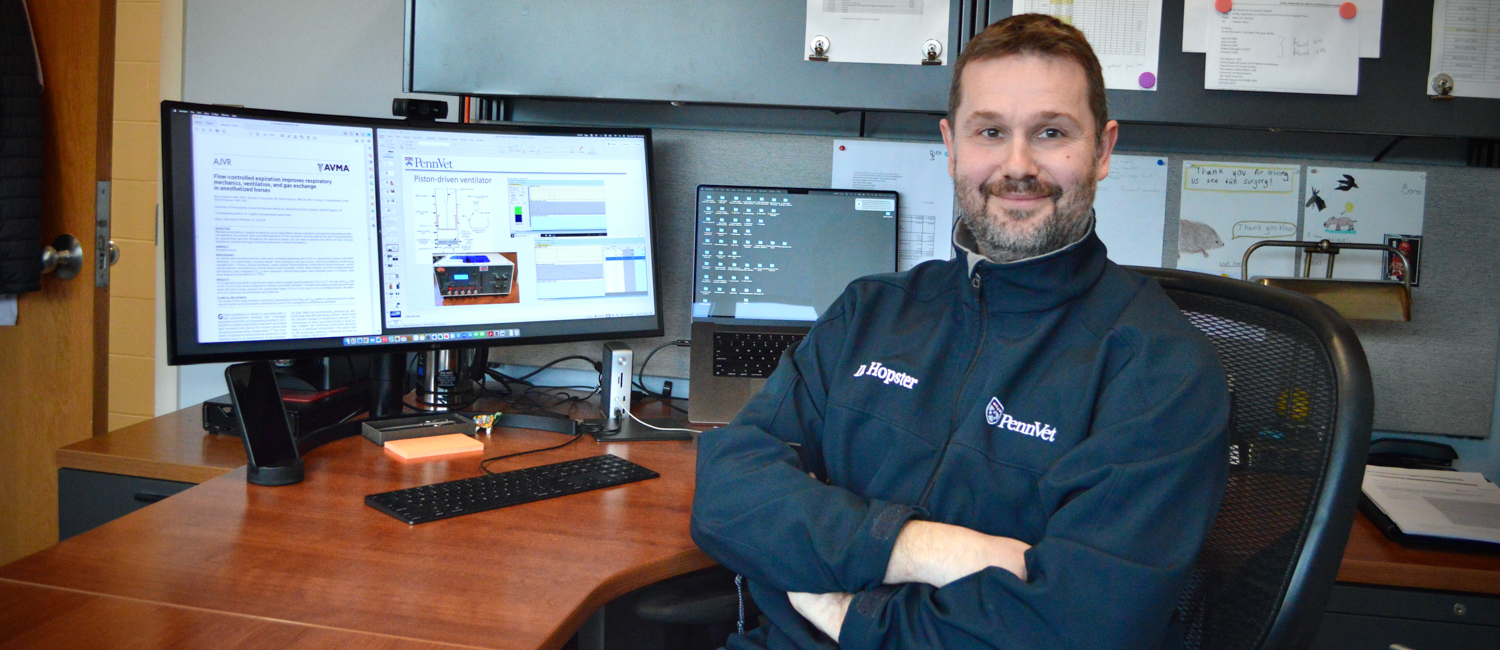
Klaus Hopster, DVM, PhD, DECVAA, is the Marilyn M. Simpson Associate Professor of Large Animal Anesthesia in the Department of Clinical Studies—New Bolton Center. Dr. Hopster studied veterinary medicine at the Hannover School of Veterinary Medicine in Germany and received his DVM degree from Hannover in 2006. He then performed a rotating internship at the Hannover Equine Hospital while enrolled in a doctoral program that he completed in 2007, with a thesis entitled, Open-lung-concept ventilation during general anesthesia of the horse and its influence on the early post-operative period. During this time, his research focused on pulmonary gas exchange in anesthetized horses.
From 2007 to 2011, Dr. Hopster was enrolled in an ECVAA-approved veterinary anesthesia and analgesia residency program. During these four years, he developed experience with all veterinary species, including small animals, large animals, exotic species, and laboratory animals, and with a wide variety of procedures, including elective and emergency surgical and diagnostic procedures. After the successful conclusion of this program, he obtained the ECVAA diplomate status.
Upon finishing his training program, Dr. Hopster accepted the position of Senior Lecturer in Anesthesia, Pain Management, and Critical Care at the Hannover School of Veterinary Medicine's Equine Hospital. He held this position until his departure to the University of Pennsylvania in 2016. During this time, his research, including his habilitation thesis, strongly focused on developing new strategies to prevent ventilation/perfusion mismatching during general anesthesia. Further, he was involved in the development of multiple ventilation approaches and concepts to improve ventilation and pulmonary mechanics in compromised patients, as well as in the development of new technologies and monitoring devices, including a thermal-mass flowmeter, to establish and improve non-invasive, real-time pulmonary diagnostics.
Since joining the University of Pennsylvania faculty, his research focus has been a mix of experimental in vivo models focused on pulmonary function and clinical studies to improve the clinical service and impact how we practice and train the next generation of anesthesiologists. As an example of Dr. Hopster's clinical and teaching methodology, the main research emphasis is advancement in understanding the developmental pathways of pulmonary impairments under general anesthesia. During his postdoc career, this approach was recognized and rewarded with the Wiley Blackwell Award and the Hippiatrika Award for excellence in veterinary medicine-related research.
In addition to clinical improvements in ventilation and aeration of the equine lung, several original publications spearheaded changes in the hospital management of high-risk patients. These published ventilation strategies are continually modified and updated to a program entitled Large Animal Anesthesia Workstation Tafonius, which provides simple and effective ways to improve ventilation of the horse during general anesthesia.
Another focus of Dr. Hopster's work was the construct and impact of various carrier gases during large animal anesthesia and how low-density gases are superior to pure oxygen in certain clinical situations with lung pathologies. Heliox, a combination of helium and oxygen, is now routinely used at New Bolton Center for complex upper airway surgeries.
The large animal anesthesia service at New Bolton Center is also a leader in large animal analgesia, incorporating epidural anesthesia as a routine technique that provides suitable long-term analgesia for large animal patients experiencing chronic pain. The large animal anesthesia service has employed the use of long-term epidural catheterization as one method of bettering the quality of life and animal welfare in the New Bolton Center hospital environment. It has successfully extended this technique, historically limited to the pelvic limbs, to the thoracic limbs using a cranial cervical approach for such clinical problems as equine laminitis. The use of a new transversus abdominis plane block in small ruminants and a pressure-sensing device further expands the analgesia toolbox for the large animal patient. These advances in local analgesia significantly improve animal welfare and anesthesia outcomes, as supported by colleagues in human medicine.
Dr. Hopster's research focuses on pulmonary oxygen uptake and oxygen delivery to the peripheral circulation and tissues. The main reasons for hypoxemia during general anesthesia are: 1.) poorly or non-aerated lung tissue; 2.) atelectasis resulting in substantial ventilation-perfusion mismatch; and 3.) pulmonary shunting equaling up to 33% of cardiac output. These anesthetic changes are the cause of high anesthesia-related morbidity, resulting in a protracted hospital stay, post-operative colic, and a high mortality rate in the horse.
Dr. Hopster's doctoral and habilitation theses (Dr. rer. nat.) in the field of pulmonary pathophysiology and its treatment under general anesthesia prepared him for his professional journey in the specialty of clinical anesthesia. Collaborative research projects in ventilation and oxygen delivery are ongoing with colleagues at the University of Michigan, University of Copenhagen, University of Pennsylvania, University of Delaware, University of Illinois, University of Texas, University of Hannover, University of Vienna, and University of Glasgow.
A new ventilation modality for large animals with the potential to change how we ventilate large animal patients was developed by Dr. Hopster with the assistance of Penn Vet's anesthesia group. The design is a FLow-controlled EXpiration (FLEX) ventilation method that actively decreases the rate of lung emptying and modulates the otherwise passive expiration phase. This is achieved by reducing the initial high-expiratory peak flow and causing the expiratory gas flow to persist throughout the expiratory phase. FLEX improves oxygenation and gas exchange in horses by altering the distribution of inspired ventilation due to more uniform homogeneous lung emptying during expiration.